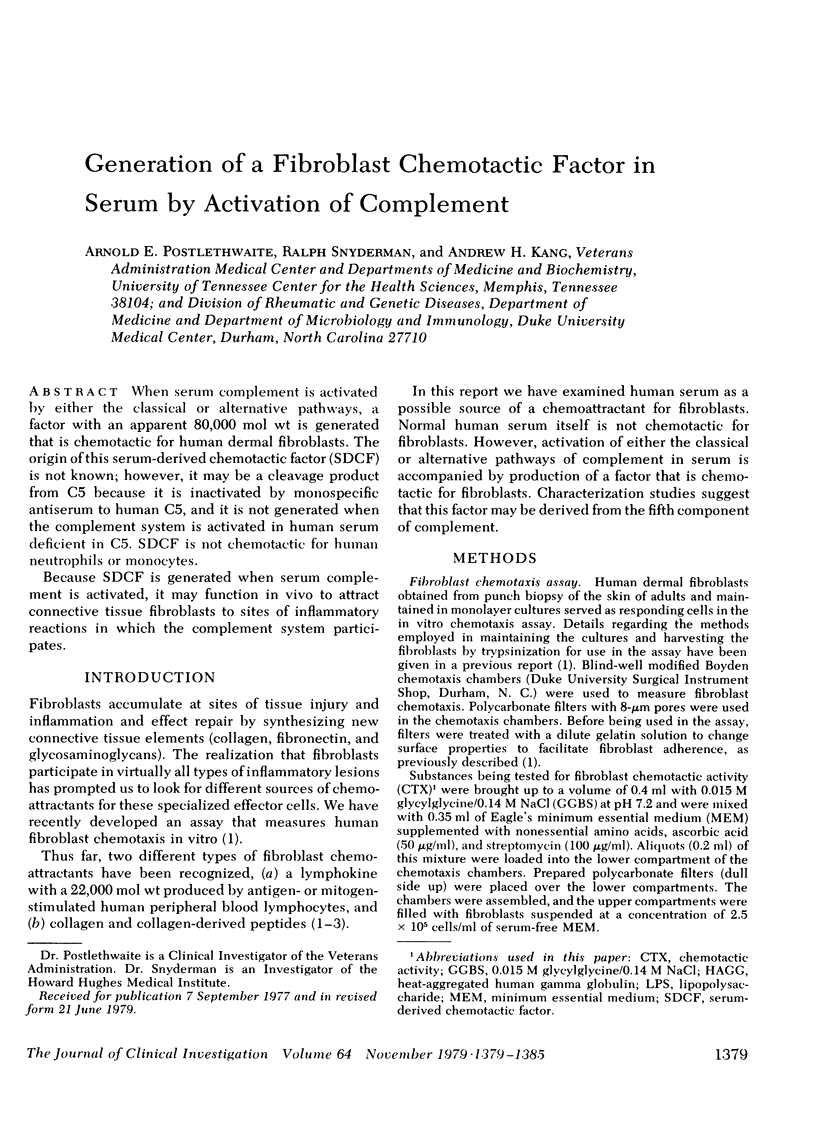Abstract
When serum complement is activated by either the classical or alternative pathways, a factor with an apparent 80,000 mol wt is generated that is chemotactic for human dermal fibroblasts. The origin of this serum-derived chemotactic factor (SDCF) is not known; however, it may be a cleavage product from C5 because it is inactivated by monospecific antiserum to human C5, and it is not generated when the complement system is activated in human serum deficient in C5. SDCF is not chemotactic for human neutrophils or monocytes. Because SDCF is generated when serum complement is activated, it may function in vivo to attract connective tissue fibroblasts to sites of inflammatory reactions in which the complement system participates.
Full text
PDF






Selected References
These references are in PubMed. This may not be the complete list of references from this article.
- Chiang T. M., Postlethwaite A. E., Beachey E. H., Seyer J. M., Kang A. H. Binding of chemotactic collagen-derived peptides to fibroblasts. The relationship to fibroblast chemotaxis. J Clin Invest. 1978 Nov;62(5):916–922. doi: 10.1172/JCI109219. [DOI] [PMC free article] [PubMed] [Google Scholar]
- Cochrane C. G., Müller-Eberhard H. J., Aikin B. S. Depletion of plasma complement in vivo by a protein of cobra venom: its effect on various immunologic reactions. J Immunol. 1970 Jul;105(1):55–69. [PubMed] [Google Scholar]
- Cuatrecasas P. Insulin--receptor interactions in adipose tissue cells: direct measurement and properties. Proc Natl Acad Sci U S A. 1971 Jun;68(6):1264–1268. doi: 10.1073/pnas.68.6.1264. [DOI] [PMC free article] [PubMed] [Google Scholar]
- Gabbiani G., Le Lous M., Bailey A. J., Bazin S., Delaunay A. Collagen and myofibroblasts of granulation tissue. A chemical, ultrastructural and immunologic study. Virchows Arch B Cell Pathol. 1976 Aug 11;21(2):133–145. doi: 10.1007/BF02899150. [DOI] [PubMed] [Google Scholar]
- Hartveit F., Borve W., Thunold S. Serum complement levels and response to turpentine inflammation in mice. Acta Pathol Microbiol Scand Suppl. 1973;236(0):54–59. [PubMed] [Google Scholar]
- Hausman M. S., Snyderman R., Mergenhagen S. E. Humoral mediators of chemotaxis of mononuclear leukocytes. J Infect Dis. 1972 Jun;125(6):595–602. doi: 10.1093/infdis/125.6.595. [DOI] [PubMed] [Google Scholar]
- Kono T., Barham F. W. The relationship between the insulin-binding capacity of fat cells and the cellular response to insulin. Studies with intact and trypsin-treated fat cells. J Biol Chem. 1971 Oct 25;246(20):6210–6216. [PubMed] [Google Scholar]
- Lewis E., Turk J. L. Comparison of the effect of various antisera and cobra venom factor on inflammatory reactions in guinea-pig skin. I. Non-specific inflammation due to the intradermal injection of turpentine. J Pathol. 1975 Feb;115(2):97–109. doi: 10.1002/path.1711150206. [DOI] [PubMed] [Google Scholar]
- Postlethwaite A. E., Kang A. H. Collagen-and collagen peptide-induced chemotaxis of human blood monocytes. J Exp Med. 1976 Jun 1;143(6):1299–1307. doi: 10.1084/jem.143.6.1299. [DOI] [PMC free article] [PubMed] [Google Scholar]
- Postlethwaite A. E., Seyer J. M., Kang A. H. Chemotactic attraction of human fibroblasts to type I, II, and III collagens and collagen-derived peptides. Proc Natl Acad Sci U S A. 1978 Feb;75(2):871–875. doi: 10.1073/pnas.75.2.871. [DOI] [PMC free article] [PubMed] [Google Scholar]
- Postlethwaite A. E., Snyderman R., Kang A. H. The chemotactic attraction of human fibroblasts to a lymphocyte-derived factor. J Exp Med. 1976 Nov 2;144(5):1188–1203. doi: 10.1084/jem.144.5.1188. [DOI] [PMC free article] [PubMed] [Google Scholar]
- Schilling J. A. Wound healing. Physiol Rev. 1968 Apr;48(2):374–423. doi: 10.1152/physrev.1968.48.2.374. [DOI] [PubMed] [Google Scholar]
- Snyderman R., Altman L. C., Hausman M. S., Mergenhagen S. E. Human mononuclear leukocyte chemotaxis: a quantitative assay for humoral and cellular chemotactic factors. J Immunol. 1972 Mar;108(3):857–860. [PubMed] [Google Scholar]
- Snyderman R., Shin H., Dannenberg A. M., Jr Macrophage proteinase and inflammation: the production of chemotactic activity from the fifth complement by macrophage proteinase. J Immunol. 1972 Oct;109(4):896–898. [PubMed] [Google Scholar]
- Ward P. A. A plasmin-split fragment of C'3 as a new chemotactic factor. J Exp Med. 1967 Aug 1;126(2):189–206. doi: 10.1084/jem.126.2.189. [DOI] [PMC free article] [PubMed] [Google Scholar]
- Zigmond S. H., Hirsch J. G. Leukocyte locomotion and chemotaxis. New methods for evaluation, and demonstration of a cell-derived chemotactic factor. J Exp Med. 1973 Feb 1;137(2):387–410. doi: 10.1084/jem.137.2.387. [DOI] [PMC free article] [PubMed] [Google Scholar]


